In 1984, the Museum of London installed twenty-one ceramic plaques around the City of London marking the line of the Roman wall, but in 2016, how many of them remain?
At the time, a fairly rough guide to the route was produced by the museum, which is still available online, and apart from the route of the London Wall, includes mentions of other since lost parts of London, such as the Spitalfields fruit market, Broad Street station and the Bankside power station.
The map is only a rough guide though, and thanks to the changing landscape in London, slowly losing even the vague relevance it once had.
The Roman Wall Plaques
Plaque One
The route starts at the Tower of London, just by the visible remains of the London Wall. It’s notable for being larger than the remaining plaques, but also for being the only one that isn’t numbered. Number One has no number. Or maybe there was a number one next to it, which has since been lost.
The section of Roman wall found here is known as the Tower Hill Postern Gate, and is not actually roman, but a medieval gatehouse associated with the Tower of London. It does however sit on the site of an earlier Roman gatehouse, but by the 18th century, the medieval replacement was lost under London’s buildings and not uncovered again until excavations in 1979.
Plaque Two
A short trot up the stairs, dodging confused tourists wondering what to do when the tube is closed for the weekend, and next another slab of Roman Wall, and a statue is Plaque Two.
This is one of the largest, and certainly highest sections of Roman wall still visible, although only the bottom half is original Roman, the upper half being medieval repairs. Standing in front of the wall is the statue of the Roman Emperor, Trajan, installed in the late 18th century.
Plaque Three
According to the map, plaque three is around the back of Tower Hill tube station, beside offices. Today that’s a posh hotel, and you can see the large chunk of Roman Wall in the car park, with a nice use of a gap to create a walk through. A walk through which is useful, as the plaque is on the other side.
This is also a sizeable section of wall, again the height being enhanced by later medieval work, but as it is “hidden” in a car park at the back of a hotel, it’s not as well known as many others dotted around the City of London.
Plaque Four
And following the route marked on the map, under the railway arches past the pub, and here a mystery — where’s the plaque? Checking the local area map on the previous plaque and the location is now a pub. The old building was demolished and the plaque removed, although there seems to be an outstanding planning application requirement for its reinstatement.
Although the plaque has vanished, there are remains of the Roman wall in the basement of the building. This included the base of a fortification tower which is thought to have been demolished in the 13th century for reasons unknown.
What is very exciting is that the roman wall in the basement is due to be made a lot more visible. It sort of is visible if you peer through a small window on the other side of the building, but in 2019, it should become a major visitor attraction.
(Update – the City Wall at Vine Street museum opened in May 2023)
Plaque Five
A short walk takes you up towards Aldgate, and plaque number five. This is mounted low down on a wall, and behind some new bike racks.
As you might have guessed from the name, it’s one of London’s ancient gates in the Roman wall. In fact, it predates the wall and stood on the road leading up to Colchester. It was finally torn down in 1761 as it was an obstruction to road traffic.
Famously, Geoffrey Chaucer lived in the gatehouse while he worked as a customs official.
Plaque Six
Sadly Number 6 is missing, and also thanks to the amount of building works going on, I was unable to reliably locate its former location, which was in the subway under the road. The subways are all being filled in as part of a revamping of the area which was rather more car than pedestrian friendly.
This section of wall was found in 1977 during the construction of the underpass, and now that those are being filled in again it will remain hidden for future archaeologists to rediscover.
Plaque Seven
Number 7 is easier to find, being in clear view on a brick wall next to an old Jewish Synagogue.
Plaques Eight & Nine
A short walk to find number eight, but it has vanished, snatched away by modern conflict, when an IRA bomb devastated the area in 1993. Today, a tall heron tower stands where the plaque was likely to have been.
Also gone is plaque number nine, probably for the same reason as above.
This was a significant roman location though, being Bishopsgate, and while we tend to think of its religious overtones, in medieval times it was probably more famous for being where the heads of executed criminals would be displayed.
Plaque Ten
Of number 10, it is also removed, but probably more poignantly, as the supporting poles still remain in place within the grounds of All Hallows-on-the-Wall, as echoes of what was once here.
This 18th-century church replaced an earlier one that had stood on the site for over 600 years. While the wall outside is medieval, there are the remains of a Roman wall bastion underneath the church, and indeed the shape of the vestry is influenced by the subterranean structure.
Plaque Eleven
Fortunately, plaque 11 is in situ, and while in a corner with rubbish heaped up beside, it is quite an important location.
This is the site of the old Moorgate, one of the several entrances into London through the Roman Wall.
Plaque Twelve
We are now at London Wall — the modern road that is — for we’ve long been following the route of the original, but here much is changing. The old row of 1960s offices have been torn down and the highwalk along with it.
It also means that Plaque 12 is now unreachable.
Plaque Thirteen
Just around the corner though, next to the entrance to the building site can be found plaque number 13, and the rather anonymous building it is mounted upon is the site of the old Cripplegate. Without these signs, most people would have no idea of the history of what lays around them.
This roman gate declined in the post-roman years, but was rebuilt in the late 15th century as the road offered a good route to the growing village of Islington. As with the other gates though, it was demolished in the 18th century as it had become an impediment to traffic.
Plaque Fourteen
Follow the signs to plaque 14, which sits within the modern Barbican estate, but is mounted rather nicely beside the pond that run alongside another section of Roman wall.
Actually, as with much of the Roman wall, what you are looking at is medieval rebuilds. The wall often proving too useful to put buildings up against, it was maintained and repaired many times.
The pond is also not just a coincidence, as it follows the line that would have existed of an earlier ditch dug on the outside of the walls to make them harder to attack. It’s unlikely that the ditch would have been a full moat, but it was probably quite marshy, especially in this part of town.
The wall was uncovered during the development of the Barbican estate.
Incidentally, the term Barbican comes from Latin barbecana, signifying the “outer fortification of a city or castle”.
Plaque Fifteen
To get to plaque 15 though, is a case of totally ignoring the map, as much of the highwalk that it shows has since vanished.
In fact, the whole area is totally confusing, but the easiest route is to head up towards the Museum of London where there is a very famous chunk of the Roman Wall visible.
Head into the garden, then around the back of the wall, and going around a corner you’ll eventually find plaque number 15 is what is essentially now a dead-end path.
Plaques Sixteen and Seventeen
Backtracking plaques 16 and 17 seem to have vanished — one possibly behind a now private entrance and the other who knows where.
This entire section of fortifications are not in fact roman at all, not a single bit. It’s all medieval and added to the Roman wall that ran through the middle of the site.
The two towers here were built in the 13th century, and rebuilt twice following the Great Fire of London and WW2.
Plaque Eighteen
Fortunately, plaque 18 is still intact, even if it initially seems rather unloved, it’s quite an important one. Sited on a concrete underpass next to an underground car park, it marks the remains of the only surviving roman gate house. This is open on occasional Fridays, and also, if you fancy a diversion, there’s a sizable chunk of Roman wall in the car park itself.
Plaque Nineteen
Cross the road and here is one of the more visible remains of the Roman wall, laid out in private gardens belonging to The Worshipful Company of Plaisterers. There used to be a plaque here, but a recent refurbishment of the walkway beside the roman wall has swept it away.
There are modern replacement plaques, more suited to today, but it’s a pity the old one couldn’t have been retained somewhere.
As with most of the wall elsewhere, the roman remains are the lower half, with medieval on top, and patches of Victorian brick in the gaps. The site was only discovered when the buildings above were hit during WW2, which in a way makes this probably London’s last remaining undeveloped bomb site.
Plaque Twenty
Down the road, and here a very nice sunken garden on the site of an old church marks where plaque number 20 should be found. It seems that refurbishment in the 1990s may have done away with it.
So on to the final stop, does it exist, or has plaque number 21 been swept away by London’s voracious property developers?
By good fortune, it remains! Sitting next to the stairs leading up to the Museum of London, the final plaque of the walk.
This is also one of London’s gates – being Aldersgate, which is likely to be a corruption of Ealdredesgate, i.e. “gate associated with a man named Ealdrād”.
The gate was rebuilt in 1617 and was for a time the residence of the Bishop of London, but as with the other gates, it was torn down in the 18th century.
Although this is the final plaque, it’s not actually the end of the London Wall though, for that continues down towards Blackfriars, but for this relic of the 1980s, the journey is at an end.
And finally…
It’s interesting that when people look at the Roman Wall that once surrounded London, much of what they look at is not Roman at all — but medieval, or later.
What London has really lost though are the massive gatehouses, which now define the area by name only and would otherwise have been major landmarks across the city.
Sadly they were torn town when narrow gatehouses impaired road traffic, and much of the wall was either covered up, lost or simply torn down.
But today there’s a bit of a renascence in Roman London, it is starting to emerge once more.
In addition to the above mentioned plan to open up the wall for the public in Vine Street, there will be the restoration of the Temple of Mithras as a public exhibition room in the new Bloomberg Building. There are long mooted plans to do something when the 1970s office block above the Roman Bathhouses is finally redeveloped, and a number of other sites lay waiting under post-war office blocks which today would be expected to be on public display.
There’s some chatter about revamping the Amphitheatre underneath Guildhall which is currently probably more notable for its 1980s Tron style graphics than for the roman remains themselves.
It’ll take a few decades, but the walk around the Roman Wall in around 30 years time, to mark the 2,000th anniversary of the founding of Londinium should be quite spectacular.


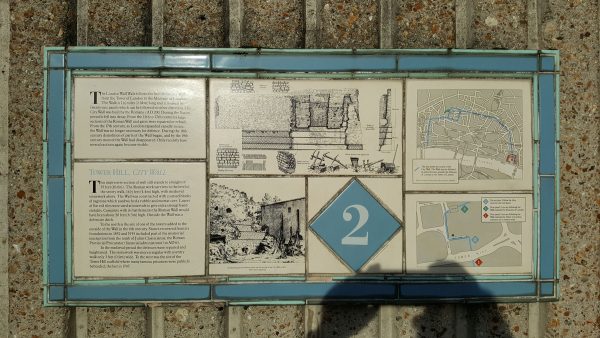


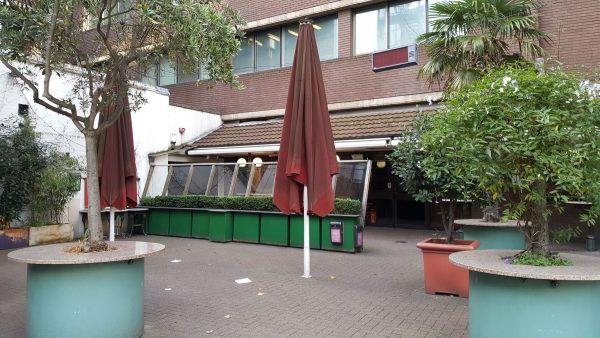
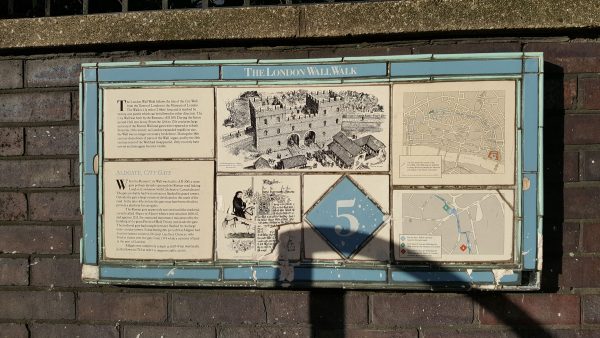



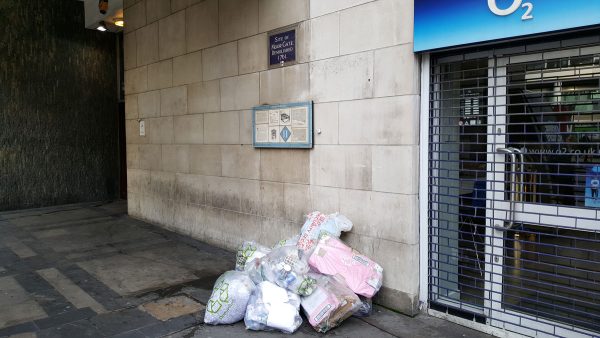
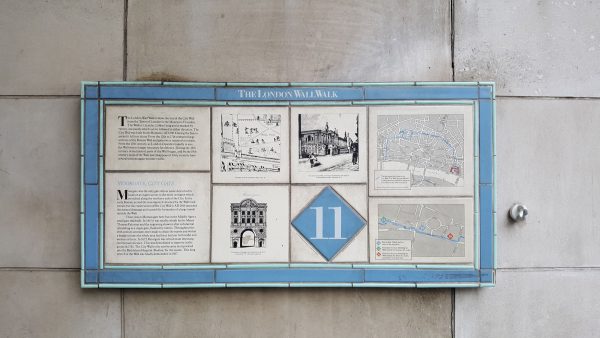

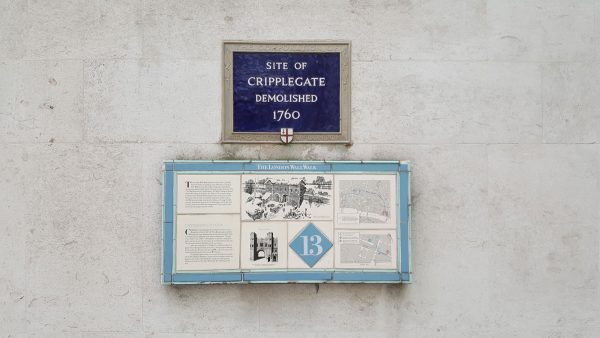
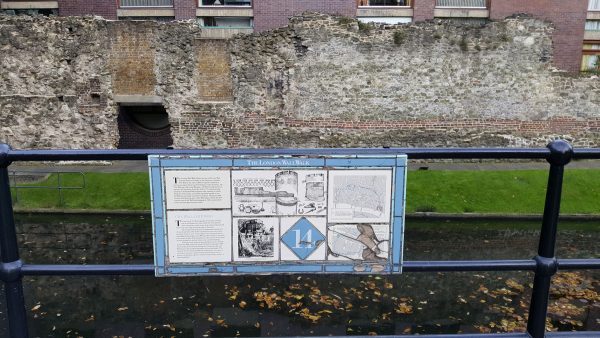

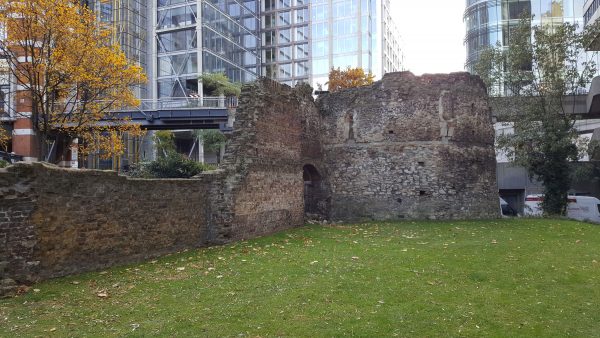
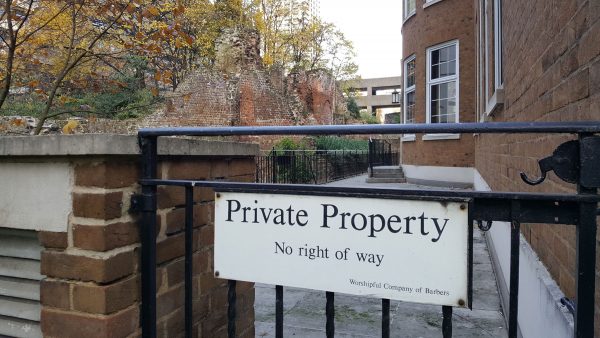
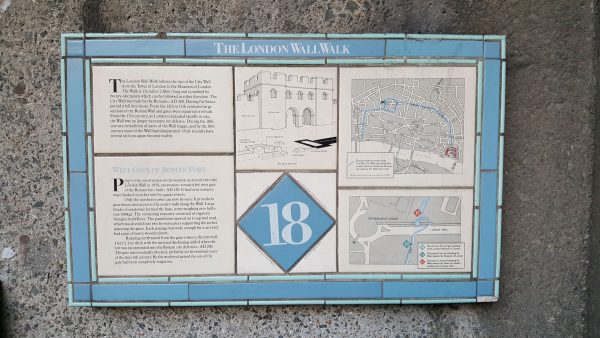

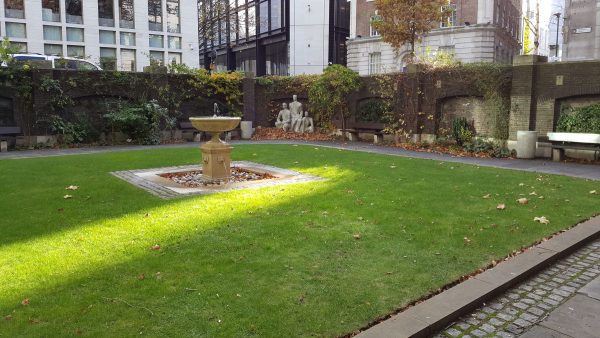







Thank you for such a thorough and thoroughly intriguing investigation. I feel inspired to follow in your footsteps and check out those locations that are still accessible.
Most interesting and thought provoking,well done
Thanks. That is definitely a walk for us, I think.
Very interesting and helpful information. I look forward to following your clues !
Thanks for the summary and I recommend walking the remaining plaques and the line of the wall. I did it when they were first installed in the mid 80s and have been round several times since.
There was indeed a numbered plaque No 1 which was mounted so as to overlook the postern gate. The unnumbered one on the wall nearby is essentially an introduction to the walk.
No 9 might have been far enough away to escape the bomb blast as it was in the gardens by St Botolph-Without-Bishopsgate, but even so it has gone.
No 12 which you couldn’t get to due to building works was in St Alphege Gardens, but was missing well before the current works.
Nos 16 & 17 were in the public area of the gardens at the side of the MoL, but have both gone.
No 18 has a duplicate in the room that enclosed the west gate of the Roman fort (although that one doesn’t have the maps that are on the one outside)
Nos 19 & 20 were both in Noble St overlooking the long run of wall alongside. No 20 marked the SW corner of the fort wall the curve of which can be seen from Noble St rather than the sunken gardens you suggest as a possible site. There are now two etched glass panels at each end of the wall remains in Noble St which are a poor replacement
The link at the start of the post is to the introduction and map pages of the book that was produced by the Museum of London. There are links to pdfs of all the other pages which include the text and the artwork from each plaque on an archived MoL page here:
http://archive.museumoflondon.org.uk/MuseumOfLondon/Templates/microsites/londinium/article_lite.aspx?NRMODE=Published&NRNODEGUID=%7B30E0F3BC-9E55-4FA6-A90E-DAB57D74371C%7D&NRORIGINALURL=%2FLondinium%2FToday%2FLondonWallWalk%2F&NRCACHEHINT=NoModifyGuest
For those who like the real thing, the book, a slim paperback, “The London Wall Walk”, 1985, ISBN 0904818136, is expensive from some dealers, but also appears on Abebooks, Amazon Marketplace, and eBay for under £5 including postage.
Great to hear what became of these plaques. I did the walk in about 1988 and even then there were gaps in the sequence, particularly around the massive building site that became the Broadgate development
Such a lot of work! Thank you so much. It took me all afternoon to find plaque 5 Aldgate. I hadn’t known about your list here.
Well done & it’s my mission to find them all too.
Great article, takes me back to the early 80’s when I first started working in the City and followed some of the plaques. A conversation about them today prompted a search on Google and finding this article. Just purchased the book on Amazon for just over a fiver and will download the pdf’s from MoL as per the other reviewers comments. Thanks
I know where plaque 9 is! A month ago I visited a client and saw it hiding behind some trees on a wall in his courtyard… I was so excited to see that I was near the London Wall but then I realized that the map was of somewhere else – not Farringdon, where it sits now. So I decided to search on Google and see if it the actual plaque had gone missing and that’s how I found this article. I won’t share the exact address as I don’t want anyone in trouble but it’s a private gated yard anyway so I hardly doubt someone will find it…
Wow! Now at Farringdon eh?! Wonder how it got there as I’m sure where it originally was in St Botolph Bishopsgate churchyard there hasn’t been much development. Shame it’s not in it’s original setting but at least it hasn’t been destroyed I guess. Thanks for the info.